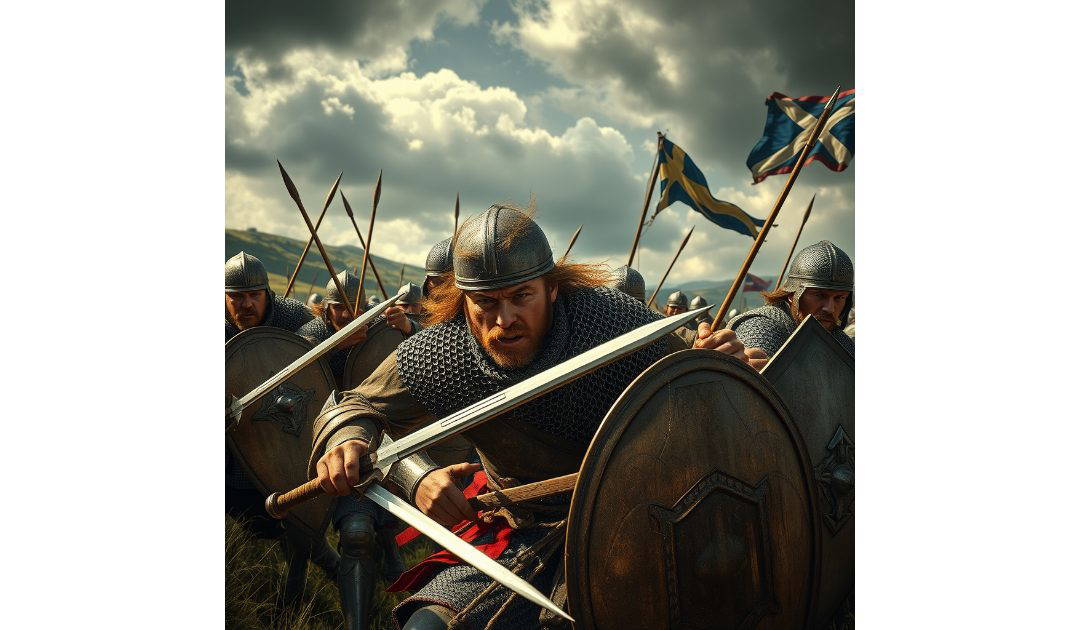On the 23rd of June, 1314, the Battle of Bannockburn began. The Battle of Bannockburn, fought over two tumultuous days, remains one of the most significant and celebrated events in Scottish history. A pivotal clash during the First War of Scottish Independence, this battle saw the forces of Robert the Bruce decisively defeat the much larger English army led by King Edward II. This victory not only solidified Robert the Bruce’s claim to the Scottish throne but also became a symbol of Scotland’s enduring struggle for sovereignty.
The roots of the Battle of Bannockburn can be traced back to the complex web of political tensions between Scotland and England. Following the death of Alexander III in 1286 and the subsequent demise of his heir, Scotland plunged into a succession crisis. King Edward I of England, known for his military prowess and ambitions for expansion, sought to exploit this turmoil, asserting his overlordship over Scotland. This led to the outbreak of the Wars of Scottish Independence in 1296.
Robert the Bruce emerged as a central figure in Scotland’s fight for independence. Crowned King of Scots in 1306, his early reign was fraught with challenges, including excommunication and military setbacks. However, through a combination of strategic acumen and relentless determination, Robert gradually consolidated his position, reclaiming Scottish castles and lands held by the English.
By 1314, the strategic Stirling Castle remained under English control, garrisoned by forces loyal to Edward II. Recognising its importance, Robert the Bruce laid siege to the castle. The English king, seeking to relieve the siege and reassert his authority over Scotland, mustered a formidable army, estimated to be between 13,000 and 20,000 men, and marched north to confront the Scots.
Robert the Bruce’s Scottish army, though significantly outnumbered with approximately 5,000-8,000 men, was composed of well-trained infantry, particularly schiltron formations—dense circles of spearmen designed to repel cavalry charges. Bruce understood the terrain would be crucial. He chose the ground near Bannockburn, with marshes, woodland, and the River Forth constraining the movement of Edward’s larger force.
The battle commenced on the 23rd of June with skirmishes. A notable encounter occurred when Henry de Bohun, an English knight, spotted Robert the Bruce riding a small horse, seemingly vulnerable. Seizing the opportunity, de Bohun charged. In a dramatic moment etched into history, Bruce sidestepped de Bohun’s lance and, with a single mighty blow of his battle axe, slew the knight. This act of personal bravery not only demoralised the English but also galvanised the Scottish troops.
The main engagement unfolded the following day. The Scots advanced from the woods, their schiltrons resembling giant hedgehogs of spear points. The English cavalry charged repeatedly but struggled against the disciplined Scottish formations and the constrictive terrain. English archers, initially effective, were driven off by Scottish cavalry under Sir Robert Keith.
King Edward II’s forces, hemmed in and disorganised, found themselves trapped against the Bannock Burn (a stream) and the surrounding marshes. The Scottish soldiers pressed their advantage relentlessly. The English line collapsed into chaos, with soldiers fleeing in panic. Many drowned in the marshes or were cut down as they tried to escape.
Edward II himself narrowly avoided capture, retreating to Dunbar before fleeing to England. His ignominious flight marked the end of the battle and a momentous triumph for Scotland.
The victory at Bannockburn had profound implications for Scotland. It solidified Robert the Bruce’s position as King of Scots and invigorated the Scottish independence movement. Although the war continued for another 14 years, culminating in the Treaty of Edinburgh-Northampton in 1328, Bannockburn remained the conflict’s defining victory.
The battle’s legacy resonates through Scottish culture and identity. Celebrated in songs, poems, and historical accounts, it became a symbol of national pride. The Bannockburn Heritage Centre near Stirling allows visitors to explore the battle’s history, with immersive exhibits bringing the medieval conflict to life.
Bannockburn’s influence extended beyond Scotland. It demonstrated the effectiveness of infantry over cavalry in medieval warfare and marked a decline in the dominance of heavily armoured knights. Robert the Bruce’s tactical innovations and leadership became subjects of military study for generations.

